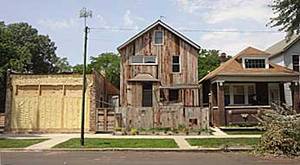Future Now
The IFTF Blog
Block by Block Creativity
Last year, for the first time in nine decades, the population of major cities grew faster than their suburbs. If this tidal shift in population movement continues, what will it mean for cities?
 As demand for space rises, undeveloped and underdeveloped places are likely to come under increasing pressure, pushing those with the fewest resources to the urban fringes or even to the suburbs. Already Salt Lake City and Seattle have modified their zoning laws to allow multi-unit dwellings on what were once single unit lots. San Francisco and New York City are leading the way in micro-apartments, closet-sized residential units that offer a break from sky-high real estate prices. Some economists envision this as an “hourglass economy” with a large class of well-heeled elites at the top, a shrinking middle class in the center, and a large class of low-income service workers at the bottom.
As demand for space rises, undeveloped and underdeveloped places are likely to come under increasing pressure, pushing those with the fewest resources to the urban fringes or even to the suburbs. Already Salt Lake City and Seattle have modified their zoning laws to allow multi-unit dwellings on what were once single unit lots. San Francisco and New York City are leading the way in micro-apartments, closet-sized residential units that offer a break from sky-high real estate prices. Some economists envision this as an “hourglass economy” with a large class of well-heeled elites at the top, a shrinking middle class in the center, and a large class of low-income service workers at the bottom.
In this scenario, blocks and neighborhoods that lie outside the mainstream of economic and cultural action—such as San Francisco’s Bayview-Hunter’s Point or Greater Grand Crossing on the South side of Chicago—become ripe for commercial development and accelerating cost of living.
But a new, emergent class of artists and activists is positioning themselves between the market and these sorts of communities. Their work disrupts the traditional pattern of neighborhood gentrification. I call these activists “block by block creatives.”
Block by block creatives are usually homegrown, self-financed and prefer to operate outside of institutional settings. They view themselves as intermediaries between runaway commercialism and human scale community development, finding ways to build communities through art, culture and all manner of free-form invention. Their power lies in their ability to capture the imagination of a block or a neighborhood and encourage a community to see itself and its future in a new light.
In Chicago, the visual artist Theaster Gates launched a movement known as the Dorchester Projects, named for the block where he is using the proceeds of his art sales to rehab abandoned buildings with the goal of creating an artists’ colony. Gates has already opened up a cinema house, an art library, and a community garden. A performance space and artist studios and housing are in the works. In a neighborhood that has seen little but neglect over the past few decades, Gates seeks organic growth that will resist speculators. His neighbors, several of whom Gates employs, are ecstatic that their block suddenly has a story that does not include deterioration or abandonment, and holds a positive future in which they play a real part.
In San Francisco, the Quesada Gardens initiative has drawn attention for its success in changing what was once a block of wary homeowners into a community of shared purpose. Their focal point is a central community garden, which they collectively rehabilitated from a trash heap that blighted their block. The garden, now rich with produce, provides fresh food. But what is really important about the Quesada Initiative is not the garden, but the gardeners, who, led by Jeffrey Betcher, now view themselves and their community as creating a new future for themselves.
These block by block creative are the focus of my fellowship project here at the Institute for the Future. I see signs of them at work—not just in San Francisco and Chicago, but also in Florida, in Sao Paolo, Brazil, in Berlin, Germany and Bogota, Colombia. What they accomplish on a small scale will create ripples that help shape the cities of tomorrow to a human scale.
 David Thigpen is an IFTF 2013 "Future for Good" Fellow. The Future for Good Fellowship Program starts with six fellows joining us for several months—from May-August 2013—to create visions and develop actions for our collective good.
David Thigpen is an IFTF 2013 "Future for Good" Fellow. The Future for Good Fellowship Program starts with six fellows joining us for several months—from May-August 2013—to create visions and develop actions for our collective good.



